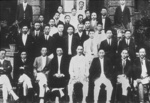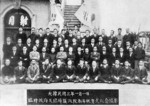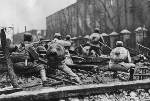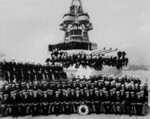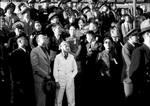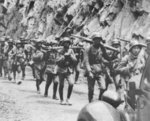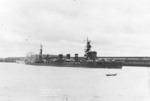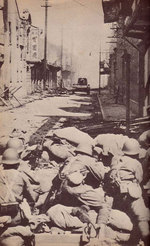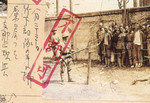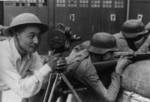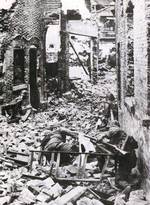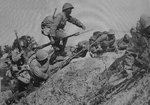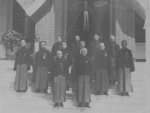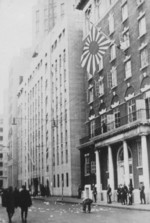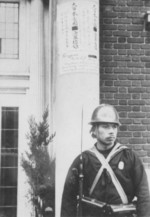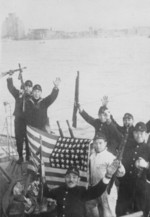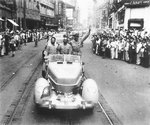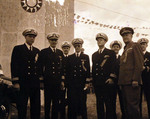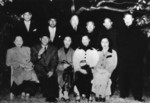20 Sep 1865
China
China
- Jiangnan Arsenal was established in Shanghai, China. Li Hongzhang was named its first commanding officer. ww2dbase [Jiangnan Arsenal | Shanghai | CPC]
5 Mar 1898
China
China
- Song Meiling was born in Hongkou District, Shanghai, China. ww2dbase [Song Meiling | Shanghai | CPC]
16 Jun 1924
China
China
- USS Stewart supported the aerial circumnavigation of four US Army Air Corps Douglas World Cruiser biplane seaplanes near Shanghai, China. ww2dbase [Shanghai | CPC]
9 May 1925
China
China
- Clifton Cates was assigned to the 4th Marine Regiment. ww2dbase [Clifton Cates | Shanghai | CPC]
14 Mar 1926
China
China
27 Mar 1926
China
China
16 Aug 1926
China
China
4 Apr 1927
China
China
- Bai Chongxi purged communists from the Nationalist Chinese garrison in Shanghai, China and a number of labor leaders in the city; many of them were executed. ww2dbase [Bai Chongxi | Shanghai | CPC]
5 Apr 1927
China
China
- Chiang Kaishek declared martial law in Shanghai, China as the first step of a bloody purge against Communists. ww2dbase [Chiang Kaishek | Shanghai | CPC]
7 Jul 1927
China
China
- The county of Shanghai in China was raise to a city status. ww2dbase [Shanghai | CPC]
14 Jul 1927
China
China
- The city of Shanghai was given the status of a municipality directly controlled by the Chinese central government. ww2dbase [Shanghai | CPC]
10 Nov 1927
China
China
- Chiang Kaishek arrived in Shanghai, China from Japan. ww2dbase [Chiang Kaishek | Shanghai | CPC]
23 Mar 1928
China
China
16 Jan 1929
China
China
- The keel of Minquan was laid down at the Jiangnan Arsenal in Shanghai, China. ww2dbase [Jiangnan Arsenal | Minquan | Shanghai | CPC]
5 Aug 1929
China
China
- Clifton Cates was assigned to 4th Marine Regiment in Shanghai, China. ww2dbase [Clifton Cates | Shanghai | CPC]
6 Sep 1929
China
China
- Clifton Cates was made an athletic director within the 4th Marine Regiment in Shanghai, China. ww2dbase [Clifton Cates | Shanghai | CPC]
21 Sep 1929
China
China
- Minquan was launched at the Jiangnan Arsenal in Shanghai, China. ww2dbase [Jiangnan Arsenal | Minquan | Shanghai | CPC]
28 Jun 1931
China
China
- The keel of light cruiser Pinghai was laid down at the Jiangnan Arsenal in Shanghai, China with Chinese Secretary of the Navy Chen Shaokuan in attendence. ww2dbase [Jiangnan Arsenal | Pinghai | Shanghai | CPC]
23 Jul 1931
China
China
- Song Ziwen survived an assassination attempt at the Shanghai North Railway Station in Shanghai, China. ww2dbase [Song Ziwen | Shanghai | CPC]
1 Oct 1931
China
China
- Clifton Cates was promoted to the rank of major. ww2dbase [Clifton Cates | Shanghai | CPC]
20 Jan 1932
China
China
- Japan demanded China to dissolve anti-Japanese organizations and pay compensation for losses incurred due to Chinese boycotts of Japanese goods. ww2dbase [First Battle of Shanghai | Shanghai | CPC]
28 Jan 1932
China

China
- The First Battle of Shanghai began in China. ww2dbase [First Battle of Shanghai | Shanghai | CPC]

29 Jan 1932
China
China
- Japanese aircraft attacked the Chapei district of Shanghai, China, causing 1,000 deaths, most of which were civilian. ww2dbase [First Battle of Shanghai | Shanghai | CPC]
1 Feb 1932
China
China
- Japanese carrier Hosho and the Japanese Navy Destroyer Division 3 arrived off Shanghai, China to support the battles in the city. Also on this day, the United Kingdom and the United States demanded Japan to cease the fighting in Shanghai. ww2dbase [First Battle of Shanghai | Shanghai | CPC]
5 Feb 1932
China
China
- Light carrier Hosho launched aircraft to attack Shanghai, China. ww2dbase [Hosho | Shanghai | CPC]
- Two Japanese bombers and three carrier-borne (Hosho) biplane fighters engaged in dogfights with Chinese Air Force fighters over Shanghai, China. ww2dbase [First Battle of Shanghai | Shanghai | CPC]
7 Feb 1932
China
China
- Light carrier Hosho launched aircraft to support ground troops at Shanghai, China. ww2dbase [Hosho | Shanghai | CPC]
- Part of the air groups from Japanese carriers Kaga and Hosho was dispatched to Shanghai, China to support fighting on the ground. ww2dbase [First Battle of Shanghai | Shanghai | CPC]
22 Feb 1932
China
China
- Three Japanese carrier-borne (Kaga) bombers, escorted by six fighters, was attacked by Chinese fighters over Shanghai, China; a biplane, piloted by American volunteer Robert Short, shot down one bomber before being shot down himself. ww2dbase [First Battle of Shanghai | Shanghai | CPC]
29 Feb 1932
China
China
- Japanese 11th Infantry Division landed near Liuhe behind Chinese lines in Shanghai, China. ww2dbase [First Battle of Shanghai | Shanghai | CPC]
1 Mar 1932
China
China
- Chinese troops launched a counterattack at Shanghai, China, but it failed to break Japanese lines. ww2dbase [First Battle of Shanghai | Shanghai | CPC]
2 Mar 1932
China
China
- Chinese 19th Route Army indicated that it was running out of supplies and was preparing to withdraw from Shanghai, China. ww2dbase [First Battle of Shanghai | Shanghai | CPC]
3 Mar 1932
China
China
- Chinese 19th Route Army and the 5th Army withdrew from Shanghai, China. ww2dbase [First Battle of Shanghai | Shanghai | CPC]
6 Mar 1932
China
China
- China agreed to the League of Nations demand to stop fighting in and near Shanghai, but Japanese forces continued to attack Chinese positions. ww2dbase [First Battle of Shanghai | Shanghai | CPC]
8 Mar 1932
China
China
- Fighting ceased in Shanghai, China, thus ending the First Battle of Shanghai. ww2dbase [First Battle of Shanghai | Shanghai | CPC]
14 Mar 1932
China
China
- League of Nations representatives arrived in Shanghai, China in an attempt to force the Japanese to negotiate with the Chinese for a ceasefire. ww2dbase [First Battle of Shanghai | Shanghai | CPC]
29 Apr 1932
China



China
- Yoshinori Shirakawa was seriously wounded by a bomb planted by Korean nationalist Yun Bong-gil at Hongkou Park (now Lu Xun Park) in Shanghai, China; Shirakawa would die of his wounds a month later. ww2dbase [Yoshinori Shirakawa | Shanghai | CPC]
- Kichisaburo Nomura was blinded in the right eye by an attack by Korean nationalist Yun Bong-gil at Hongkou Park (now Lu Xun Park) in Shanghai, China. ww2dbase [Kichisaburo Nomura | Shanghai | CPC]
- Kenkichi Ueda lost his left leg to a bomb planted by Korean nationalist Yun Bong-gil at Hongkou Park (now Lu Xun Park) in Shanghai, China. ww2dbase [Kenkichi Ueda | Shanghai | CPC]
- Yun Bong-gil detonated a bomb at Hongkou Park (now Lu Xun Park) in Shanghai, China, killing General Yoshinori Shirakawa and Government Chancellor Kawabata Sadaji. He failed to get away and was arrested. ww2dbase [Yun Bong-gil | Shanghai | CPC]



5 May 1932
China
China
- Japan and China signed the Shanghai Ceasefire Agreement, which made Shanghai off-limits for Chinese troops while it allowed some Japanese units to remain in the city. ww2dbase [First Battle of Shanghai | Shanghai | CPC]
25 May 1932
China
China
- Yun Bong-gil was convicted of murder for the death of Yoshinori Shirakawa and Kawabata Sadaji in Shanghai, China. ww2dbase [Yun Bong-gil | Shanghai | CPC]
26 May 1932
China
China
- Yoshinori Shirakawa passed away in Shanghai, China from wounds sustained during a bomb blast one month prior. ww2dbase [Yoshinori Shirakawa | Shanghai | CPC]
6 Jun 1932
China
China
- Clifton Cates was detached from 4th Marine Regiment in Shanghai, China. ww2dbase [Clifton Cates | Shanghai | CPC]
8 Aug 1932
China
China
- Hiroshi Nemoto arrived in Shanghai, China. ww2dbase [Hiroshi Nemoto | Shanghai | CPC]
3 Jun 1935
China
China
- In Shanghai, China, Kong Xiangxi announced that the currency of the Republic of China was to be printed by the Central Bank, Bank of China, and the Bank of Communications as of 4 Nov 1935. Any private institutions holding silver coins and silver ore were to exchange them with those three banks beginning on that date. ww2dbase [Kong Xiangxi | Shanghai | CPC]
28 Sep 1935
China

China
- Light cruiser Pinghai was launched at the Jiangnan Arsenal in Shanghai, China. ww2dbase [Jiangnan Arsenal | Pinghai | Shanghai | CPC]

16 Jul 1937
China
China
25 Jul 1937
China
China
9 Aug 1937
China
China
- Chinese Peace Preservation Corps troops shot and killed Japanese Special Naval Landing Forces Lieutenant Isao Oyama as he attempted to enter Hongqiao Airport, Shanghai, China without authorization. ww2dbase [Second Battle of Shanghai | Shanghai | CPC]
10 Aug 1937
China
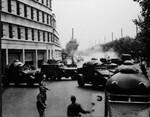
China
- Japanese Consul General in China demanded the Chinese to withdraw the Peace Preservation Corps from Shanghai due to the death of Lieutenant Isao Oyama at Hongqiao Airport on the previous day. Meanwhile, additional Japanese troops began arriving in Shanghai. ww2dbase [Second Battle of Shanghai | Shanghai | CPC]

12 Aug 1937
China
China
- USS Augusta delivered 50 Marines and 57 Navy personnel to reinforce the US 4th Marine Regiment stationed at Shanghai, China. ww2dbase [Augusta | Shanghai | CPC]
- Liu Cuigang flew his first combat mission of the Second Sino-Japanese War, attacking Japanese warships at the mouth of the Yangtze River in the Shanghai area in eastern China in a Hawk III fighter. The mission was called off due to weather. ww2dbase [Liu Cuigang | Shanghai | CPC]
13 Aug 1937
China
China
- Japanese troops and men of Chinese Peace Preservation Corps exchanged small arms fire at the Zhabei, Wusong, and Jiangwan districts of Shanghai, China starting at 0900 hours, thus opening the Second Battle of Shanghai. At 1500 hours, Japanese troops crossed the Bazi Bridge in Zhabei district amidst mortar attacks by troops of Chinese 88th Division. At 1600 hours, warships of Japanese 3rd Fleet bombarded Chinese positions. ww2dbase [Second Battle of Shanghai | Shanghai | CPC]
- Units of the US 4th Marine Regiment were assigned to reinforce the Municipal Police of the international zone in Shanghai, China. ww2dbase [Shanghai | CPC]
14 Aug 1937
China

China
- Liu Cuigang, commanding officer of the 24th Pursuit Squadron of the Chinese 5th Pursuit Group flying a Hawk III fighter, claimed the squadron's first victory, an E8N seaplane, near Shanghai, China; Japanese records showed no E8N aircraft lost on that date. ww2dbase [Liu Cuigang | Shanghai | CPC]
- Liu Zhesheng, flying a Hawk III fighter, shot down a G3M bomber of Japanese Kanoya Air Group near Shanghai, China. He shared this victory with fellow pilot Li Guidan or his wingman Lieutenant Wang Wenhua. ww2dbase [Second Battle of Shanghai | Liu Zhesheng | Shanghai | CPC]
- A Chinese aircraft, en route to attack Japanese warships off Shanghai, China, accidentally released a bomb over the international section of Shanghai. The bomb hit the Cathay and Palace Hotels near the waterfront at 1627 hours, killing many Chinese and western civilians. The killed included American citizens Robert Reischauer, Frank Rawlinson, Hubert Honigsberg, and Mrs. Honigsberg. ww2dbase [Second Battle of Shanghai | Shanghai | CPC]

15 Aug 1937
China
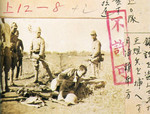
China
- Liu Cuigang engaged in aerial combat over Shanghai, China flying a Hawk III fighter, claiming the downing of a Japanese reconnaissance aircraft. ww2dbase [Liu Cuigang | Shanghai | CPC]
- Mao Yingchu, flying a Hawk III biplane fighter, claimed a Japanese B2M carrier torpedo bomber over Shanghai, China. ww2dbase [Mao Yingchu | Shanghai | CPC]
- Liu Zhesheng, flying a Hawk III fighter, shared the credit of a B2M aircraft from carrier Kaga with other pilots near Shanghai, China. He was forced to break off from the engagement after his aircraft was damaged in the fuel tank. ww2dbase [Second Battle of Shanghai | Liu Zhesheng | Shanghai | CPC]

16 Aug 1937
China
China
- Yuan Baokang, flying a Hawk III fighter, claimed an E8N floatplane over Shanghai, China as his first victory. However, Japanese records showed no such loss on this date. ww2dbase [Yuan Baokang | Shanghai | CPC]
17 Aug 1937
China
China
- Japanese light tanks halted a Chinese counter attack at Shanghai, China. Meanwhile, the first group of American evacuees departed from the international zone of Shanghai. ww2dbase [Second Battle of Shanghai | Shanghai | CPC]
- Liu Cuigang engaged in aerial combat over Shanghai, China flying a Hawk III fighter, claiming the downing of a Japanese bomber at 1940 hours. ww2dbase [Liu Cuigang | Shanghai | CPC]
19 Aug 1937
China
China
- A rifle company of two officers and 102 enlisted men arrived in Shanghai, China from Cavite, Philippine Islands to reinforce the US 4th Marine Regiment. ww2dbase [Shanghai | CPC]
20 Aug 1937
China
China
- Liu Cuigang, flying a Hawk III fighter, shot down a Japanese fighter and an E8N seaplane from seaplane carrier Kamoi after he dropped a 500-pound bomb on a Japanese troop concentration in Shanghai, China. ww2dbase [Second Battle of Shanghai | Liu Cuigang | Shanghai | CPC]
- While moored in the Huangpu River in Shanghai, China in the evening, the crew of USS Augusta gathered on the well deck for movies. A Chinese anti-aircraft shell intended for a Japanese reconnaissance aircraft flying nearby landed on the American cruiser, killing Seaman 1st Class Freddie J. Falgout and wounding 18 others. ww2dbase [Second Battle of Shanghai | Augusta | Shanghai | CPC]
21 Aug 1937
China
China
- Patrolling Japanese E8N floatplanes intercepted six Chinese Gamma 2E light bombers over the suburbs of Shanghai, China. The Japanese succeeded in forcing the Chinese to abandon the planned attack on the Kunda Texile Factory, but failed to shoot down any aircraft (but the Japanese claimed two victories). Lieutenant Yue Yiqin of the 22nd Pursuit Squadron of the Chinese 4th Pursuit Group, flying a Hawk III biplane fighter, shot down the Japanese floatplane flown by Petty Officer First Class Shigeru Yano, who survived the downing. Yano attempted to ram a Chinese aircraft as he went down; he failed to make contact as none of the Chinese fighters reported being rammed, but Yano believed he did. ww2dbase [Second Battle of Shanghai | Yue Yiqin | Shanghai | CPC]
- Photographer Harrison Forman boarded USS Augusta in Shanghai, China to document the event in which an errant Chinese anti-aircraft shell killed one American sailor and wounded 18 others. ww2dbase [Harrison Forman | Augusta | Shanghai | CPC]
23 Aug 1937
China
China
- Mutsu arrived at Shanghai, China and disembarked 2,000 troops of the Japanese Army 11th Division. ww2dbase [Second Battle of Shanghai | Mutsu | Shanghai | CPC]
- Japanese A4N biplanes from carrier Ryujo attacked a group of Chinese Hawk III biplanes over Baoshan District of Shanghai, China; Masaichi Kondo claimed two victory, while other pilots in his air group claimed an additional eight. On the Chinese side, Liu Cuigang claimed one victory at 0730 hours, Yuan Baokang claimed one damaged over Liuhe in Jiangsu Province, and Wong Sun-sui claimed one victory near Chongming Island north of Shanghai. ww2dbase [Second Battle of Shanghai | Liu Cuigang | Yuan Baokang | Wong Sun-sui | Masaichi Kondo | Shanghai | CPC]
24 Aug 1937
China
China
- Mutsu provided naval gunfire support off Shanghai, China. ww2dbase [Second Battle of Shanghai | Mutsu | Shanghai | CPC]
26 Aug 1937
China
China
- Japanese aircraft attacked a vehicle carrying the ambassador of United Kingdom during an air raid on Shanghai, China. ww2dbase [Bombing of Shanghai, Chongqing, and other Cities | Shanghai | CPC]
- A second rifle company of two officers and 102 enlisted men arrived in Shanghai, China from Cavite, Philippine Islands to reinforce the US 4th Marine Regiment; the first company of identical strength had arrived 7 days prior. ww2dbase [Shanghai | CPC]
28 Aug 1937
China
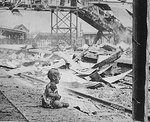


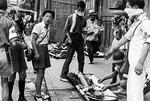
See all 28 Aug 1937 photos
China
- Wang Xiaoting, also known as H. S. "Newsreel" Wong, filmed the scenes at South Station in Shanghai, China immediately after a Japanese Navy aerial bombing. One of the stills featuring an injured and crying toddler, "Chinese Baby", would soon be seen by an estimated 25 million people world wide in the form of newsreels, newspapers, and magazines by the end of the year. ww2dbase [Second Battle of Shanghai | Wang Xiaoting | Shanghai | CPC]




See all 28 Aug 1937 photos
29 Aug 1937
China
China
- Settsu, which had ferried a battalion of Sasebo 4th Special Naval Landing Force from Japan, disembarked the troops onto light cruiser Natori and destroyer Yakaze off Shanghai, China. ww2dbase [Second Battle of Shanghai | Settsu | Shanghai | CPC]
6 Sep 1937
China
China
- Liu Cuigang, flying a Hawk III fighter, attacked Japanese warships off Shanghai, China with 500-pound bombs. ww2dbase [Second Battle of Shanghai | Liu Cuigang | Shanghai | CPC]
8 Sep 1937
China
China
- Liu Cuigang, flying a Hawk III fighter, claimed to have destroyed two Japanese tanks in Shanghai, China with bombs and claimed a Japanese fighter shot down. ww2dbase [Second Battle of Shanghai | Liu Cuigang | Shanghai | CPC]
- Cen Zeliu dropped small bombs at Japanese armored cruiser Izumo near Shanghai, China; the bomb missed the target. ww2dbase [Second Battle of Shanghai | Cen Zeliu | Shanghai | CPC]
11 Sep 1937
China
China
- Following the advice of German advisor to China Falkenhausen, Chinese troops dug in at Luodian near Shanghai to defend against a Japanese offensive. The 300,000 Chinese infantry troops would hold on to Luodian for four days against attacks by 100,000 Japanese troops with overwhelming firepower. ww2dbase [Second Battle of Shanghai | Shanghai | CPC]
15 Sep 1937
China
China
- Japanese troops took the town of Luodian near Shanghai after four days of attacks. ww2dbase [Second Battle of Shanghai | Shanghai | CPC]
19 Sep 1937
China
China
- The 2nd Marine Brigade headquarters and the US 6th Marine Regiment arrived in Shanghai, China. The US Marine Corps presence in Shanghai was now 2,536-strong. ww2dbase [Shanghai | CPC]
27 Sep 1937
China
China
- Liu Cuigang, flying a Hawk III fighter, led a flight of six others to drop 110-pound bombs on Japanese tank concentrations reported near Luodian, Shanghai, China. Failing to find the tanks but seeing Japanese fighters, Liu ordered all bombs jettisoned in order to engage the fighters. Liu would claim one Japanese fighter shot down. ww2dbase [Liu Cuigang | Shanghai | CPC]
1 Oct 1937
China
China
3 Oct 1937
China
China
4 Oct 1937
China
China
- After a 10-day rest period, the US 4th Marine Regiment returned to police duties in the international zone in Shanghai, China. ww2dbase [Shanghai | CPC]
12 Oct 1937
China
China
- Yuan Baokang, flying a stripped-down Hawk III fighter, scored a victory on Lieutenant Nambu's E8N floatplane over Shanghai, China when the two aircraft collided with each other during the dogfight. The Japanese floatplane crashed and exploded, but Yuan was able to crash land near Jiangyin, Jiangsu Province, China. ww2dbase [Yuan Baokang | Shanghai | CPC]
17 Oct 1937
China
China
- The Guanxi Army arrived in Shanghai, China to reinforce the Chinese forces. ww2dbase [Second Battle of Shanghai | Shanghai | CPC]
26 Oct 1937
China
China
- At 2200 hours, the Chinese 524th Regiment withdrew from Shanghai North Railway Station into the six-story Sihang Warehouse in Shanghai, China. ww2dbase [Second Battle of Shanghai | Shanghai | CPC]
27 Oct 1937
China
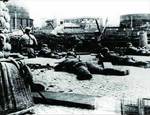

China
- After taking Shanghai North Railway Station in the morning, Japanese troops moved on to launched a small scale attack the Sihang Warehouse on the north bank of the Suzhou River in Shanghai to test Chinese defenses. The Japanese avoided using mortars and other weapons of greater firepower, including aerial bombardment, to avoid hitting the international zone just across the river. ww2dbase [Second Battle of Shanghai | Shanghai | CPC]


28 Oct 1937
China
China
- Japanese troops attacked the Sihang Warehouse in Shanghai, China with light field guns. In the evening, trucks loaded with donated supplies from Shanghai residents reached the warehouse; Japanese snipers killed three Chinese soldiers while they were unloading the trucks. ww2dbase [Second Battle of Shanghai | Shanghai | CPC]
29 Oct 1937
China


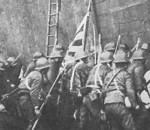
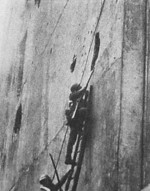
China
- A 12-foot-wide Chinese flag was raised atop the Sihang Warehouse in Shanghai, China, which was a great morale booster for the defenders fortified inside the building. Meanwhile, western officials in the international zone in Shanghai appealed to Chiang Kaishek to order the defenders in the Sihang Warehouse to withdraw, while negotiating for a short ceasefire agreement from the Japanese so that the withdraw would be conducted in peace. ww2dbase [Second Battle of Shanghai | Shanghai | CPC]




31 Oct 1937
China
China
- At midnight, the remaining 376 Chinese officers and men in the Sihang Warehouse in Shanghai, China withdrew from the building into the international zone. The evacuation was completed by 0200 hours on 1 Nov 1937. ww2dbase [Second Battle of Shanghai | Shanghai | CPC]
1 Nov 1937
China
China
- The Sihang Warehouse in Shanghai, stubbornly defended by the Chinese for four days, was evacuated between 0000 and 0200 hours. The 376 Chinese officers and men were allowed to evacuate into the international zone across the southern shore of the Suzhou River but were kept imprisoned until the outbreak of the Pacific War in 1941. ww2dbase [Second Battle of Shanghai | Shanghai | CPC]
5 Nov 1937
China
China
- Japanese 10th Army landed at Jinshanwei in the south of Shanghai, China in an attempt to surround the city. ww2dbase [Second Battle of Shanghai | Shanghai | CPC]
8 Nov 1937
China
China
- Chinese troops began to retreat from Shanghai, China. ww2dbase [Second Battle of Shanghai | Shanghai | CPC]
9 Nov 1937
China
China
- Japanese troops began the occupation of Shanghai, China. ww2dbase [Second Battle of Shanghai | Shanghai | CPC]
3 Dec 1937
China
China
1 Feb 1938
China
China
- Clifton Cates was made the commanding officer of 2nd Battalion of 4th Marine Regiment. ww2dbase [Clifton Cates | Shanghai | CPC]
7 Feb 1938
China
China
- Japanese General Iwane Matsui made a speech during a memorial service for troops of the Shanghai Expeditionary Force who were killed in combat. The speech included his order to "put an end to various reports affecting the prestige of the Japanese troops", referring to reports of atrocities committed by Japanese troops in Nanjing, China. Later on the same day he made an entry in his dairy noting that "I could only feel sadness and responsibility today, which has been overwhelmingly piercing my heart. This is caused by the Army's misbehaviors after the fall of Nanjing and failure to proceed with the autonomous government and other political plans." ww2dbase [Battle of Nanjing and the Rape of Nanjing | Iwane Matsui | Shanghai | CPC]
27 Feb 1938
China
China
- The US 2nd Marine Brigade headquarters and the US 6th Marine Regiment departed Shanghai, China. The US 4th Marine Regiment remained in Shanghai as the only American military unit there. ww2dbase [Shanghai | CPC]
29 Apr 1939
China
China
- USS Astoria arrived at Shanghai, China. ww2dbase [Astoria (New Orleans-class) | Shanghai | CPC]
1 May 1939
China
China
- Admiral Harry E. Yarnell visited USS Astoria in the morning; in the afternoon, the cruiser departed Shanghai, China for Hong Kong. ww2dbase [Astoria (New Orleans-class) | Shanghai | CPC]
18 May 1939
China
China
- Clifton Cates was made the executive officer of the 4th Marine Regiment. ww2dbase [Clifton Cates | Shanghai | CPC]
6 Jun 1939
China
China
- Clifton Cates stepped down as the executive officer of the 4th Marine Regiment. ww2dbase [Clifton Cates | Shanghai | CPC]
30 Dec 1939
China
China
- Masaichi Kondo engaged Chinese fighters above Liuzhou, Guangxi Province, China. ww2dbase [Second Battle of Shanghai | Shanghai | CPC]
14 Aug 1940
China
China
1 Sep 1941
China
China
- In China, the American Consul-General at Shanghai, the commander of the Yangtze Patrol, and the commanding officer of the 4th Marine Regiment at Shanghai recommended that all naval forces in China be withdrawn. ww2dbase [Shanghai | CPC]
27 Nov 1941
China
China
- US Navy-chartered passenger liner President Madison departed from Shanghai, China for the Philippine Islands with the 2nd Battalion of the US 4th Marine Regiment. ww2dbase [Shanghai | CPC]
28 Nov 1941
China

China
- US Navy-chartered passenger liner President Harrison departed from Shanghai, China for the Philippine Islands with the final elements of the US 4th Marine Regiment. ww2dbase [Shanghai | CPC]

29 Nov 1941
China
China
- US Navy river gunboats Luzon and Oahu departed Shanghai, China for Manila, Philippine Islands. ww2dbase [Shanghai | CPC]
7 Dec 1941
China
China
5 Aug 1942
China
China
- Tatsuta Maru arrived at Shanghai, China and embarked interned Allied personnel; she would depart later on the same day. ww2dbase [Tatsuta Maru | Shanghai | CPC]
21 Oct 1943
China
China
22 Jul 1944
China
China
- American aircraft raided Japanese positions in Shanghai, China. ww2dbase [Shanghai | CPC]
25 Mar 1945
China
China
17 Jul 1945
China
China
- Over 200 American bombers attacked Jiangwan, Shanghai, China, which held the largest concentration of Japanese aircraft in China. ww2dbase [Jiangwan Airfield | Shanghai | CPC]
18 Jul 1945
China
China
- 214 US aircraft attacked the Japanese airfield at Shanghai, China. ww2dbase [Shanghai | CPC]
24 Jul 1945
China
China
- More than 100 B-24 bombers based in Okinawa, Japan attacked Japanese airfields at Shanghai, China. ww2dbase [Shanghai | CPC]
19 Aug 1945
China
China
- US forces entered Shanghai, China to prevent Chinese communists from occupying the city. Chinese Nationalist forces would finally arrive in Shanghai on 3 Sep 1945. ww2dbase [Shanghai | CPC]
3 Sep 1945
China
China
- Large crowds welcomed Chinese troops into Shanghai, China. ww2dbase [Shanghai | CPC]
4 Sep 1945
China
China
- Milton Miles arrived in Shanghai, China by aircraft to prepared for the arrival of the US Navy 7th Fleet. ww2dbase [Milton Miles | Shanghai | CPC]
7 Sep 1945
China
China
8 Sep 1945
China
China
11 Sep 1945
China
China
16 Sep 1945
China
China
- In Shanghai, China, after being overworked, recovering from malaria (and at times overdosing on Atabrine), and taking too much Benzedrine and sleeping pills to help him work and rest, Milton Miles began showing signs of psychosis. On this date, he met with newly arrived Thomas Kinkaid in Shanghai, China; Kinkaid described Miles as suffering from "war shock". ww2dbase [Milton Miles | Shanghai | CPC]
29 Sep 1945
China
China
6 Oct 1945
China
China
11 Oct 1945
China
China
9 Nov 1945
China
China
16 Nov 1945
China
China
- Albert Wedemeyer ordered that public saluting for US servicemen in Shanghai, China was no longer required unless on official business. ww2dbase [Albert Wedemeyer | Shanghai | CPC]
- Destroyer USS Saufley arrived at Shanghai, China. ww2dbase [Saufley | Shanghai | DS]
1 Dec 1945
China
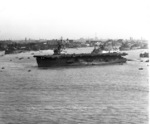

China
- The US military publication Shanghai Stars and Stripes sponsored a US Army-US Navy American football game in Shanghai, China. The passenger of the pre-game rickshaw race was crowned Miss Rickshaw 1945 and Queen of the Army-Navy Game. 1,500,000 people, Americans and Chinese, turned out to join in on the overall festivities while 20,000 attended the football game. Navy defeated Army in the game, 12 to 0. ww2dbase [Shanghai | CPC]


8 Dec 1945
China
China
- Captain Harold Baker was named the commanding officer of USS Saint Paul while at Shanghai, China. ww2dbase [Saint Paul | Shanghai | CPC]
21 Dec 1945
China
China
- USS Saint Paul and Chinese landing craft LST144 collided at Shanghai, China, causing slight damage to the cruiser's bow. ww2dbase [Saint Paul | Shanghai | CPC]
26 Jun 1946
China
China
- Allied repatriation ship Hikawa Maru arrived in Shanghai, China and embarked Japanese personnel. ww2dbase [Hikawa Maru | Shanghai | CPC]
1 Jul 1946
China
China
- Allied repatriation ship Hikawa Maru departed Shanghai, China. ww2dbase [Hikawa Maru | Shanghai | CPC]
17 Jun 1947
China
China
- War criminals Sergeant Jiro Shimoda and Captain Harochi Yonemura were executed in Shanghai, China. Shimoda had plundered and raped Chinese civilians during the occupation, including several murders committed at Jianying 85 miles northwest of Shanghai on the date of the surrender. Yonemura had ordered enlisted men under his command to bury, while alive, more than 100 Chinese civilians in Changshu near the city of Suzhou. ww2dbase [Tokyo Trial and Other Trials Against Japan | Shanghai | CPC]
26 Apr 1949
China
China
- Yan Xishan departed Shanghai, China for Guangzhou, Guangdong Province, China. ww2dbase [Yan Xishan | Shanghai | CPC]
8 May 1949
China
China
20 Nov 1950
China
China
- Song Tiancai was captured by communist forces in Shanghai, China. ww2dbase [Song Tiancai | Shanghai | CPC]
7 Apr 1968
China
China
- Chen Changjie committed suicide in Shanghai, China. ww2dbase [Chen Changjie | Shanghai | CPC]
27 Feb 1979
China
China
- The Communist Party of Shanghai, China exonerated Chen Changjie. ww2dbase [Chen Changjie | Shanghai | CPC]
Please consider supporting us on Patreon. Even $1 per month will go a long way! Thank you. Please help us spread the word: Stay updated with WW2DB: |
Search WW2DB

News
- » Wreck of Teruzuki Found (27 Jul 2025)
- » USS Orlean's Bow Found (22 Jul 2025)
- » The Emperor of Japan Planned to Honor WW2-era Japanese POWs in Mongolia (4 Jul 2025)
- » US State Lawmaker John Winter Caught Using Racial Slur "Jap" and Apologized (11 Jun 2025)
- » US Government Plans to Purge WW2 Information (17 Mar 2025)
- » See all news
Current Site Statistics
- » 1,181 biographies
- » 337 events
- » 45,115 timeline entries
- » 1,248 ships
- » 350 aircraft models
- » 207 vehicle models
- » 376 weapon models
- » 123 historical documents
- » 261 facilities
- » 470 book reviews
- » 28,412 photos
- » 365 maps
Famous WW2 Quote
"Among the men who fought on Iwo Jima, uncommon valor was a common virtue."Fleet Admiral Chester W. Nimitz, 16 Mar 1945
Support Us
Please consider supporting us on Patreon. Even $1 a month will go a long way. Thank you!
Or, please support us by purchasing some WW2DB merchandise at TeeSpring, Thank you!
